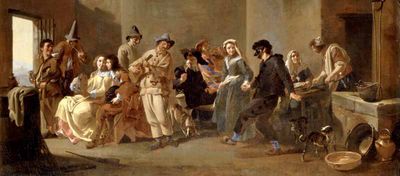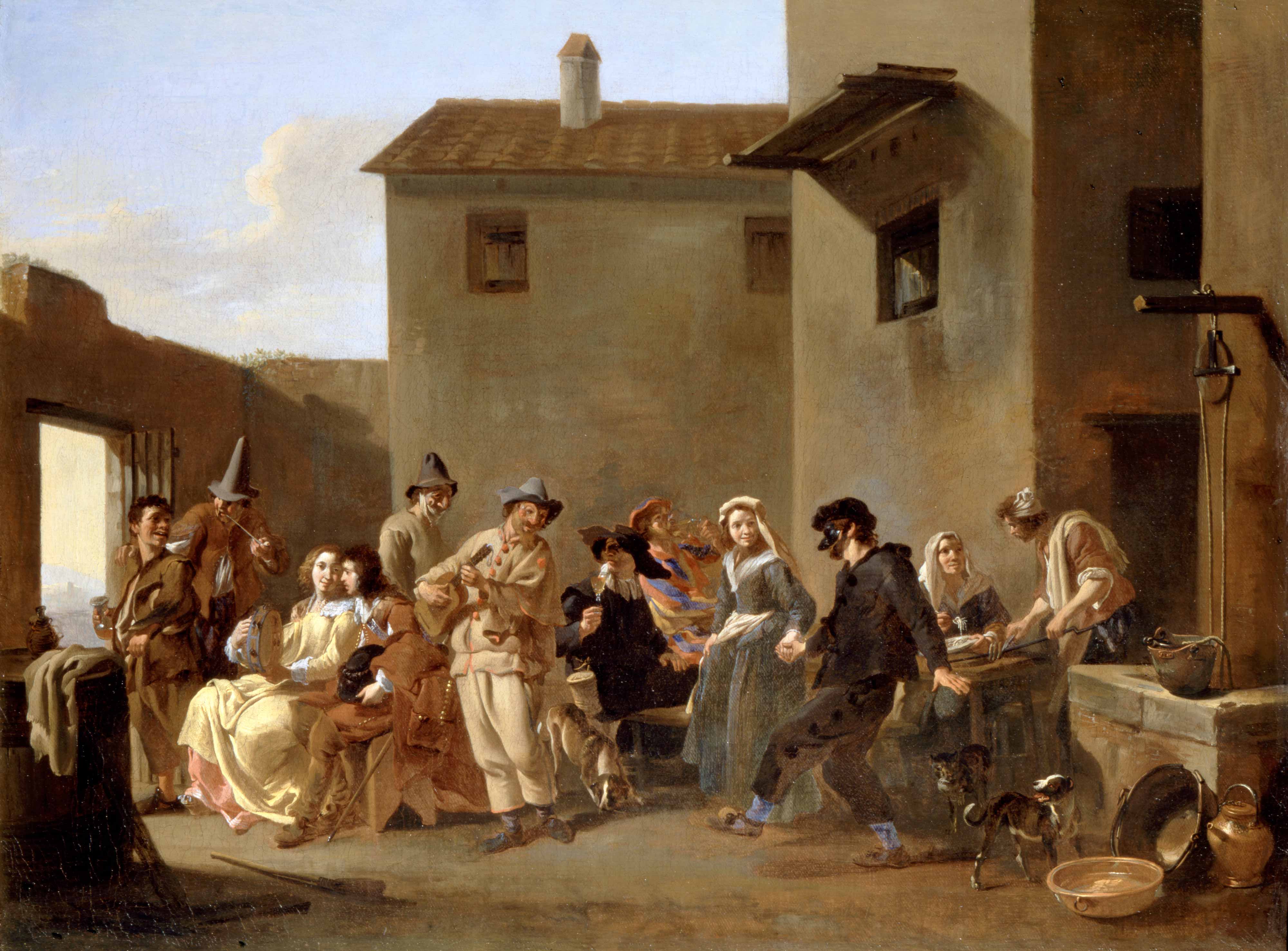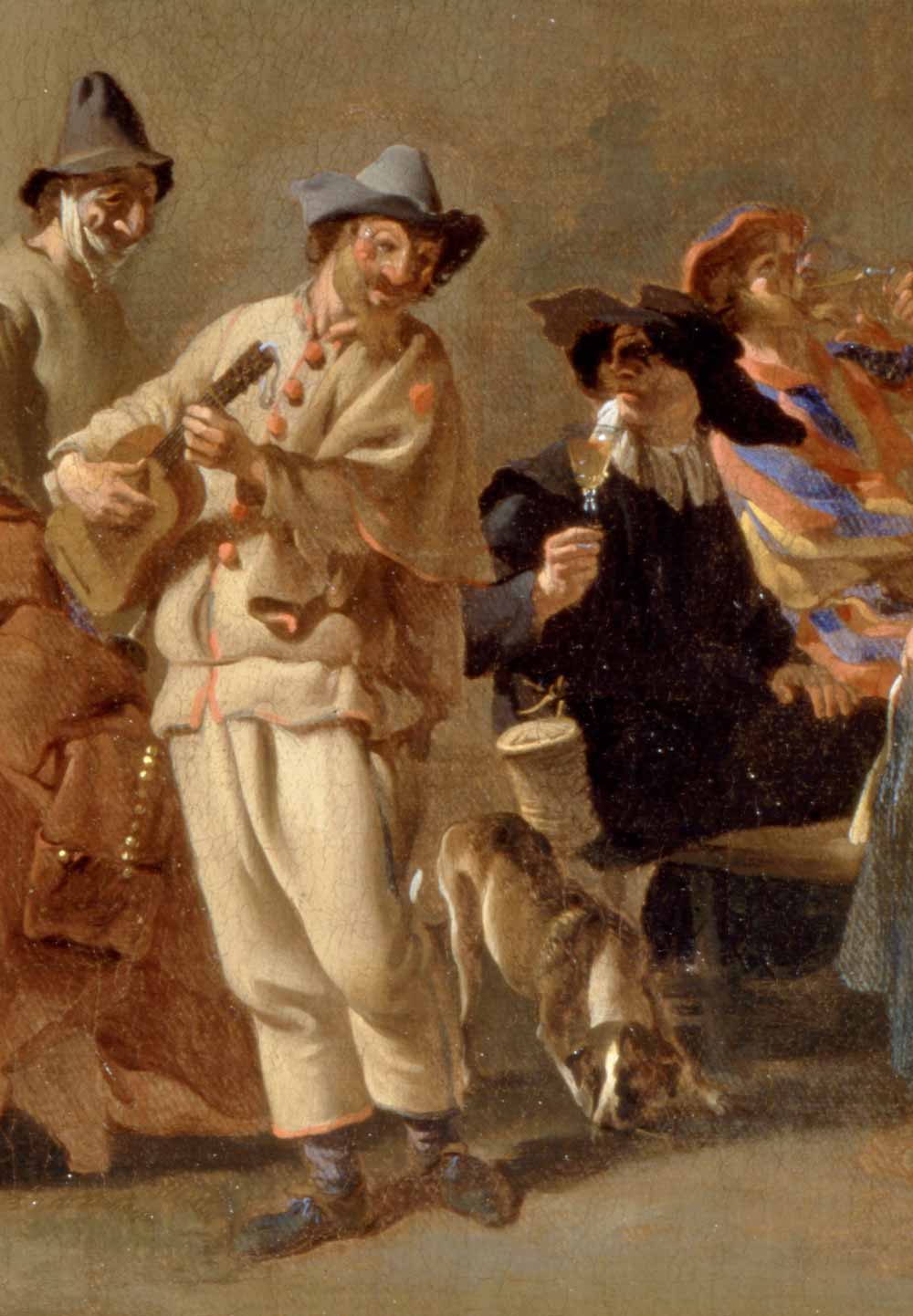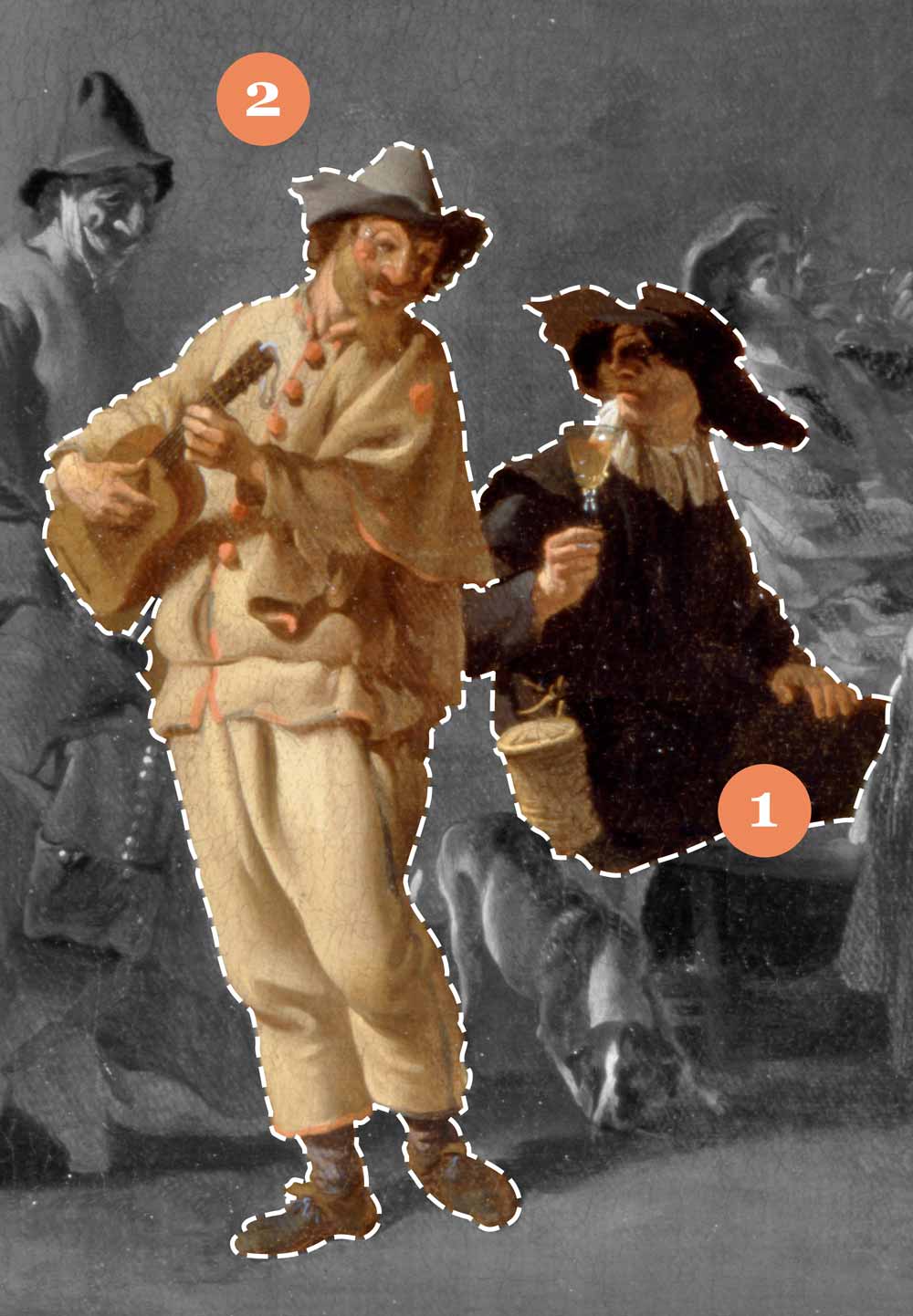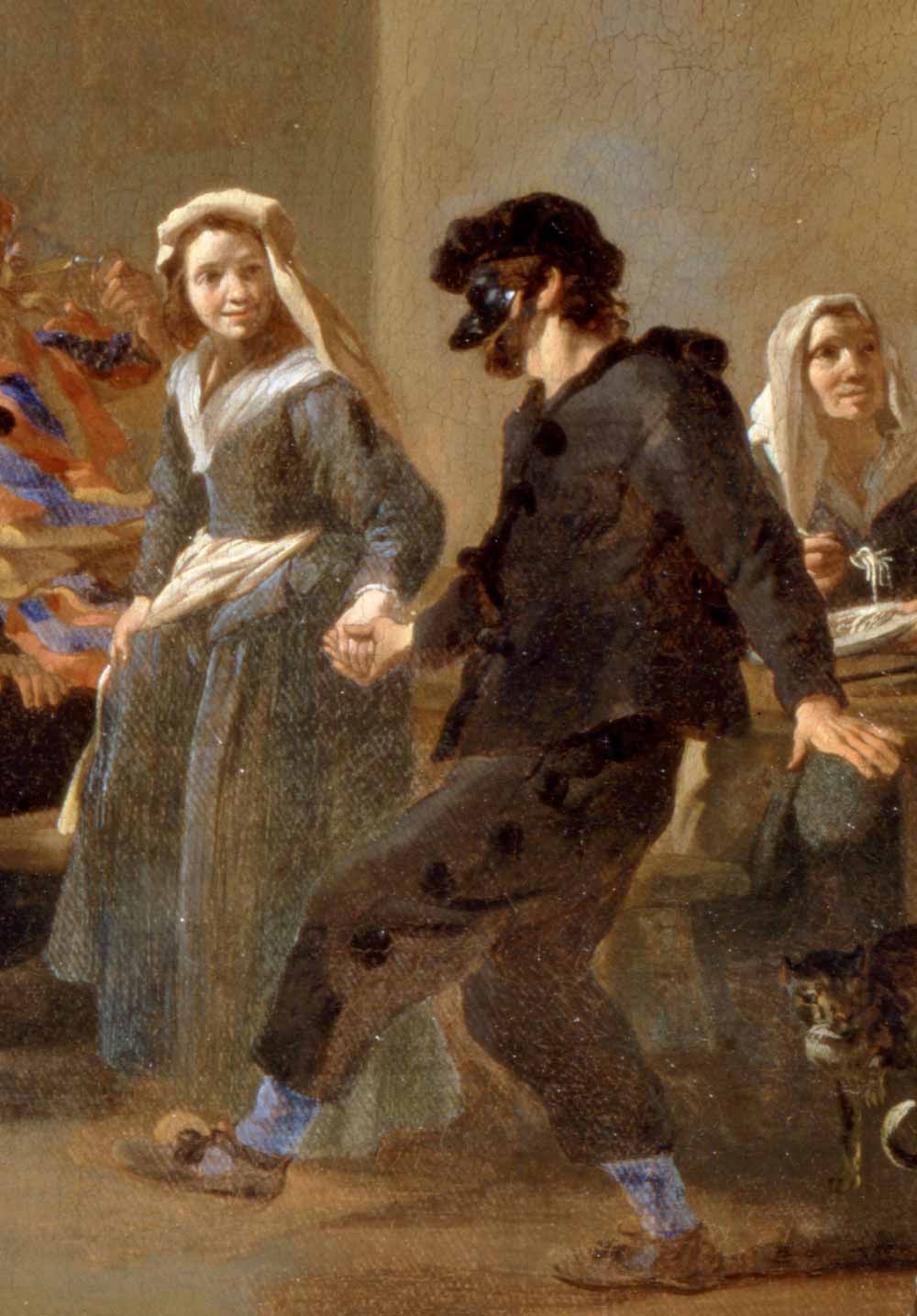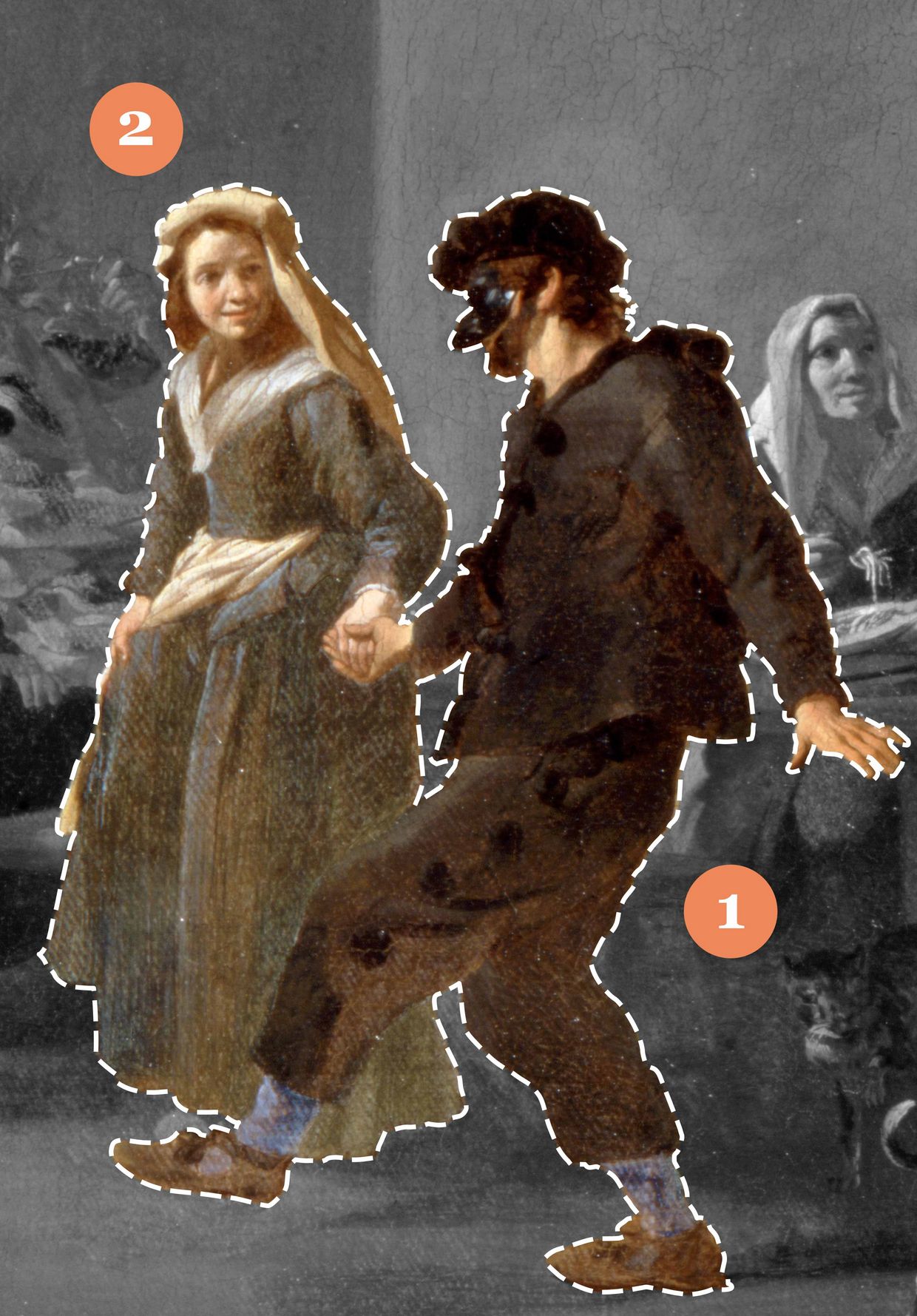Dance in the Trattoria by Jan Miel.
Masquerade or Theater?
Claudia Koch
The tavern as a place to celebrate?
Jan Miel's painting represents a merry company enjoying music, dancing and wine in the backyard of a Roman tavern. The majority of the pictured characters are costumed. Who are these people? What are they doing? Are they celebrating a mask festival? Or are they playing a comedy?
A view in the Italianate style
The courtyard door reveals a wide, sun-drenched landscape, whose shapes are blurred by the haze of the shimmering heat. Jan Miel paints this landscape following the criteria of a new style which was developed by Dutch artists on their trips to Italy. Later on, this style has been called Italianate landscape painting.
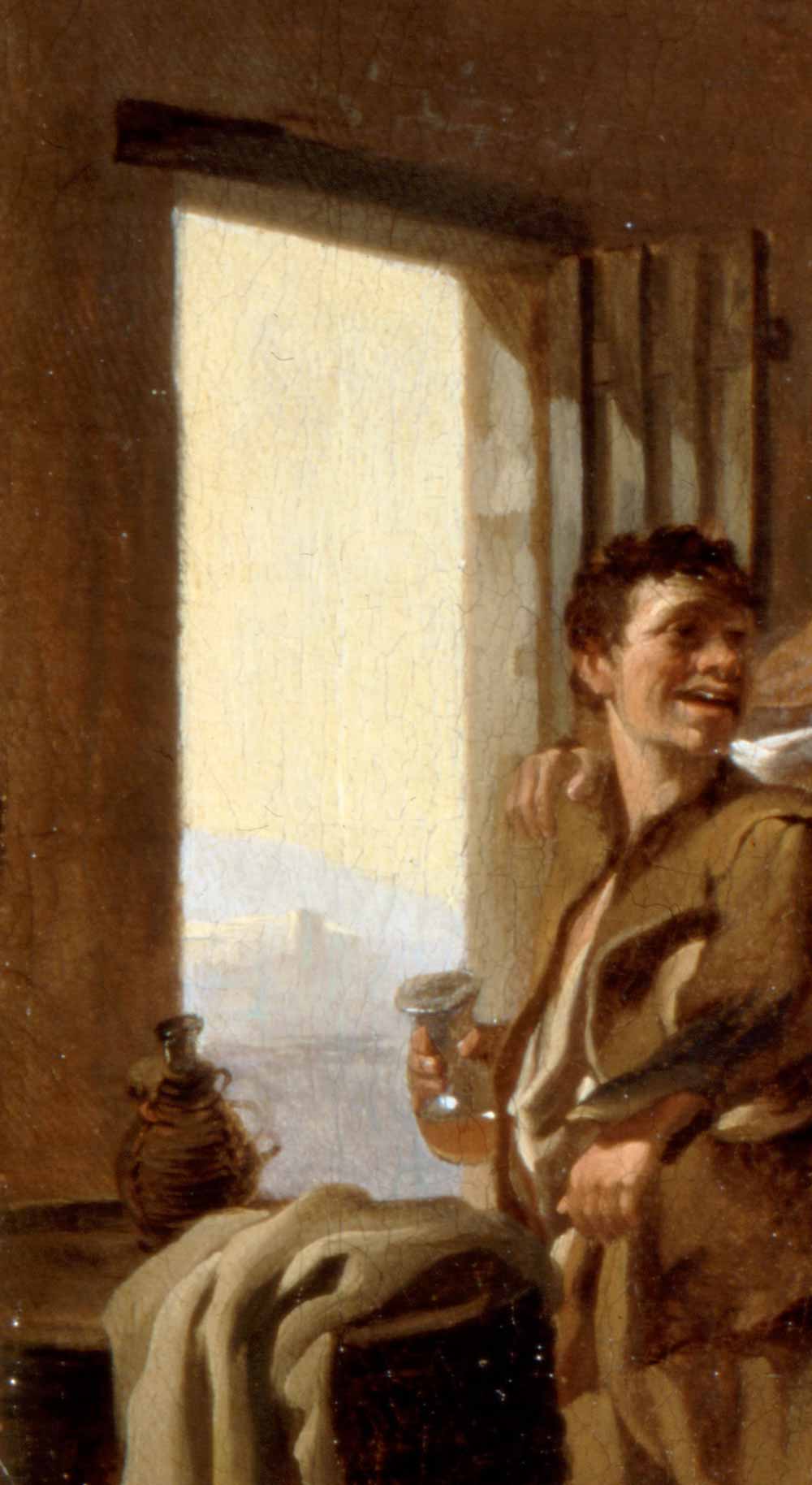

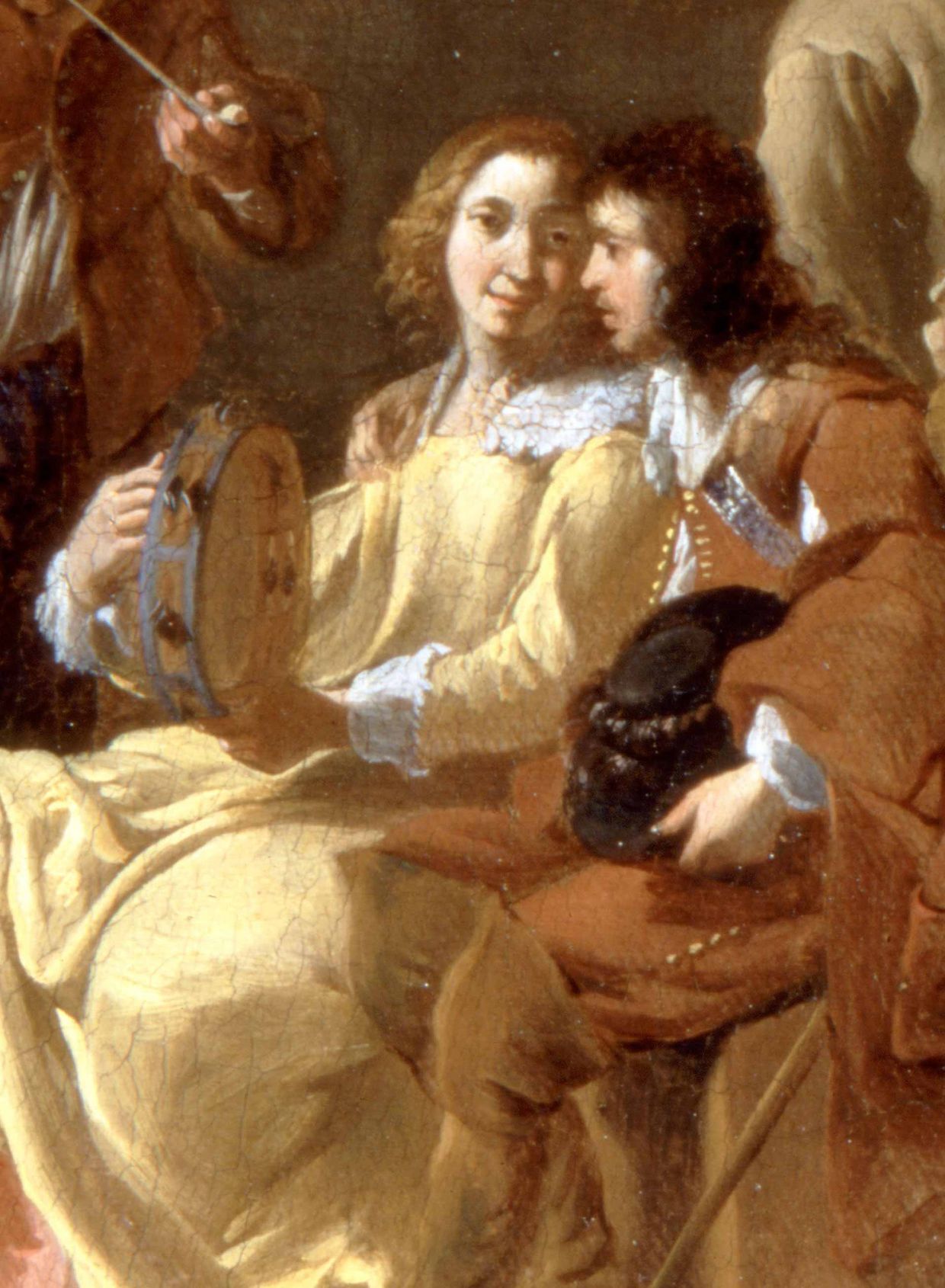
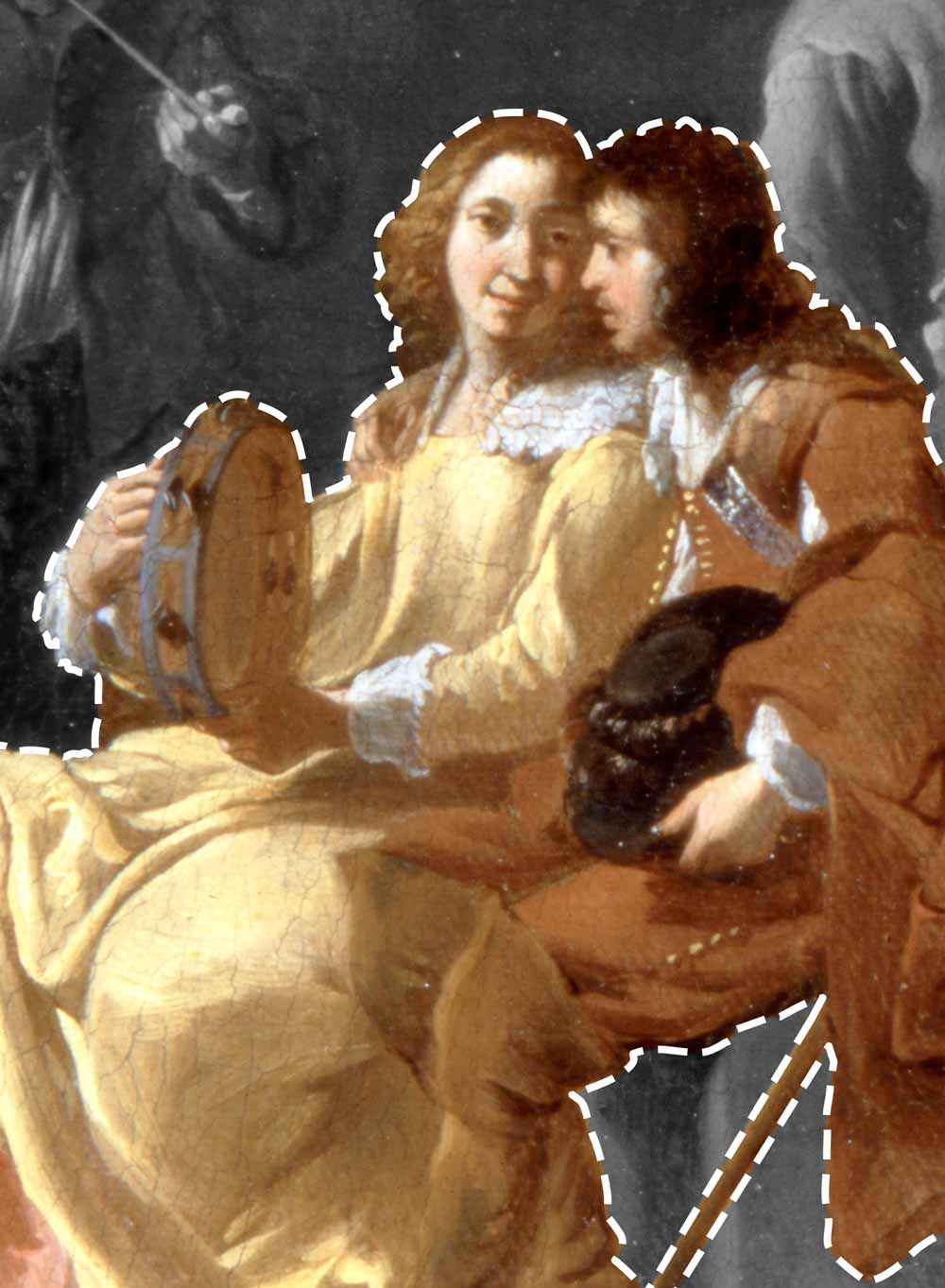
Amorosi – The Lovers
The intimate dreamy look and the close embrace suggest that the young couple is in love. Contrary to most of the figures in the painting, they do not wear masks and theatrical costumes. They are fashionably dressed and brightly made up instead.
The woman with a tambourine accompanies the guitar player to her right. She seems to tap the beat vehemently with her right foot. Her entire appearance resembles the figure
of Franceschina, as represented by Jacques Callot in the graphic series Balli Sfessania from 1623. This series was extremely popular and widely disseminated internationally.
As starting point for all sorts of comic love intrigues and misunderstandings, the young lovers, in Italian the Amorosi or the Innamorati, are essential characters of the Italian comedy, the Commedia dell'arte.
Zanni – The Servants
The Zanni are servant characters in the Commedia dell'arte and represent the lower class. Their poor and shabby clothing betray their rural origin. Over time, a large group of servant's figures has developed, with respective different regional characteristics.
The name Zanni is a diminutive of Giovanni, whose German equivalent is Johann or Hans – John in English. It is a comic figure similar to a buffoon which influenced many other figures. For example, in the German speaking area the Zanni developed to Hans-Wurst.
In principle, the Commedia dell'arte's repertoire of characters is set up in pairs. Accordingly, Jan Miel's depiction also includes two Zanni. Their different looks suggest different, or even opposite characters. The spectrum ranges from the quit-witted, cunning rascal to the foolish dolt. In our picture, the pipe smoking Zanni seems to be the smarter one. With his pot-belly and high hat, he resembles the depictions of Pulcinella.
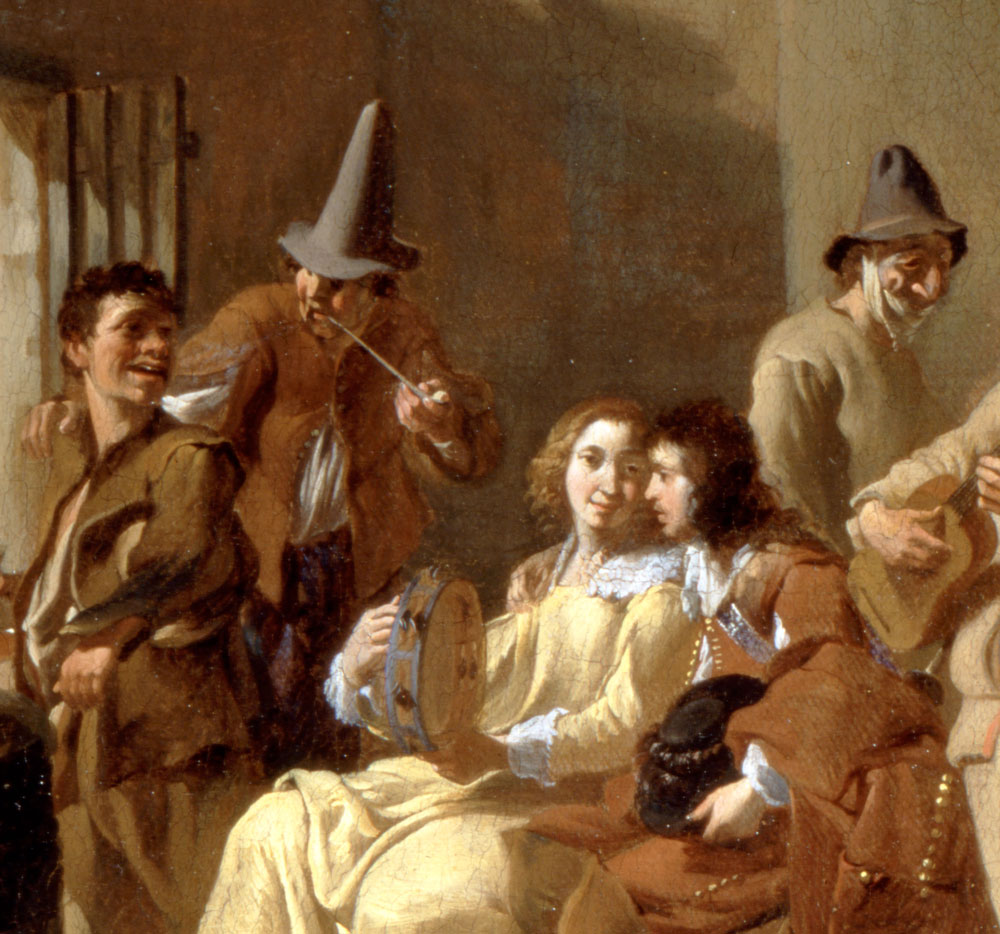
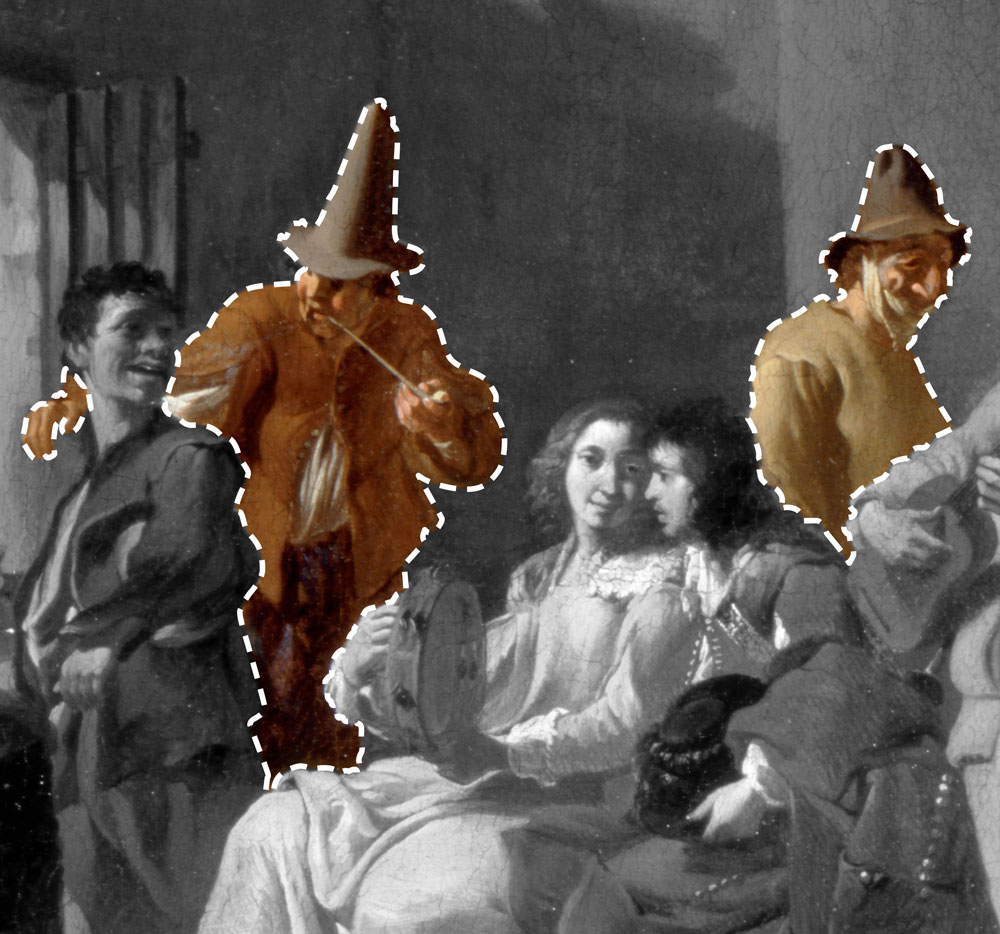
The scholared Dottore and Trivellino
1 The gentleman in black clothes with a white collar and a wide-brimmed hat marks the center of the depiction. Because of his sitting position and shaded face, he is relatively inconspicuous. He is wearing the costume of the scholared Dottore, who like most of the figures shown here belongs to the repertoire of the Commedia dell'arte.
Another important distinguishing feature of this costumed figure is the black face mask. According to legend, the Dottore was once hit by an inkwell in a dispute, the contents of which spread over his forehead and nose. Unusually, in the present picture the actor wears a brown half mask with a mustache instead of a black one. The mask does not correspond in colour to the costume tradition, however, its shape covering forehead and a prominent nose is quite typical.
As a figure of the Commedia dell'arte, the Dottore is one of theVecchi, the Elders. His counterpart is the Venetian merchant Pantalone, who is stingy in character and lustfully chases maids. He is usually characterized by a red costume and brown mask. However, in this depiction the Pantalone is missing. Perhaps here the figure of the Dottore combines both characters, a conclusion that is also suggested by his characteristic brown mask.
2 The scholared Dottore is toasting the musician of the troupe, who may act as his partner in place of the missing Pantalone. As a musician, however, this figure belongs to the group of servants. With his tassels and red decorative elements, the type of all the numerous Zanni he resembles the most is that of Trivellino.
Arlecchino
Arlecchino is probably the most famous figure among the servants. He can be recognized by his multicoloured clothing, which is made of long stripes of varied colours. Over time, the ragged and richly patched harlequin robe gradually developed into a diamond-patterned costume. In the present painting, however, this costume rather resembles the uniform of a Swiss guard.
Even if Jan Miel may have been influenced by the costumes of the Swiss guards, his Arlecchino is actually closer to the figure of the medieval minstrel and fool with stripy robe, which was common not only in the German, but also in the artist's native Flemish-Dutch culture. Its design traced back to a fringed piece of garment imitating animal skin from earlier times.
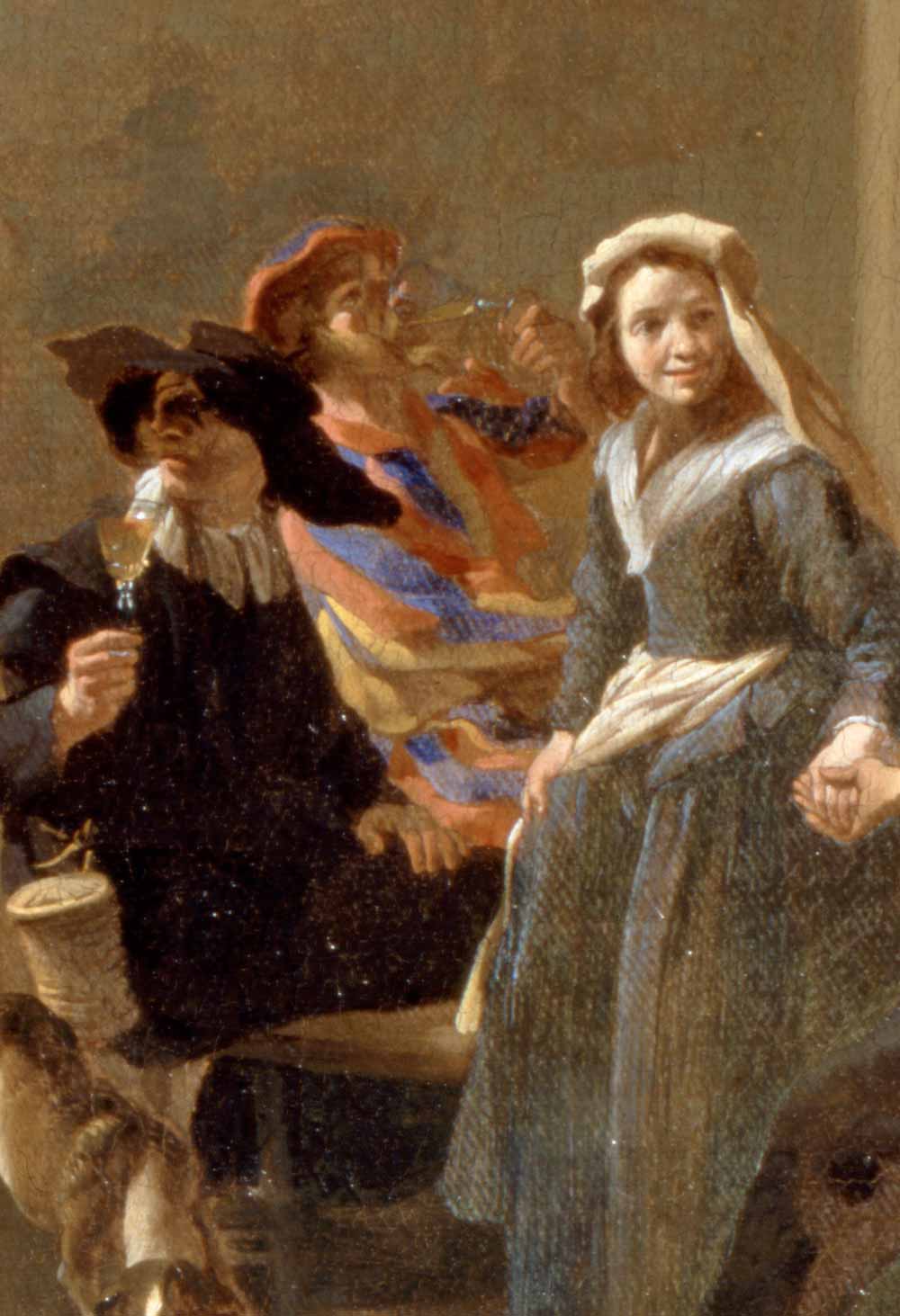
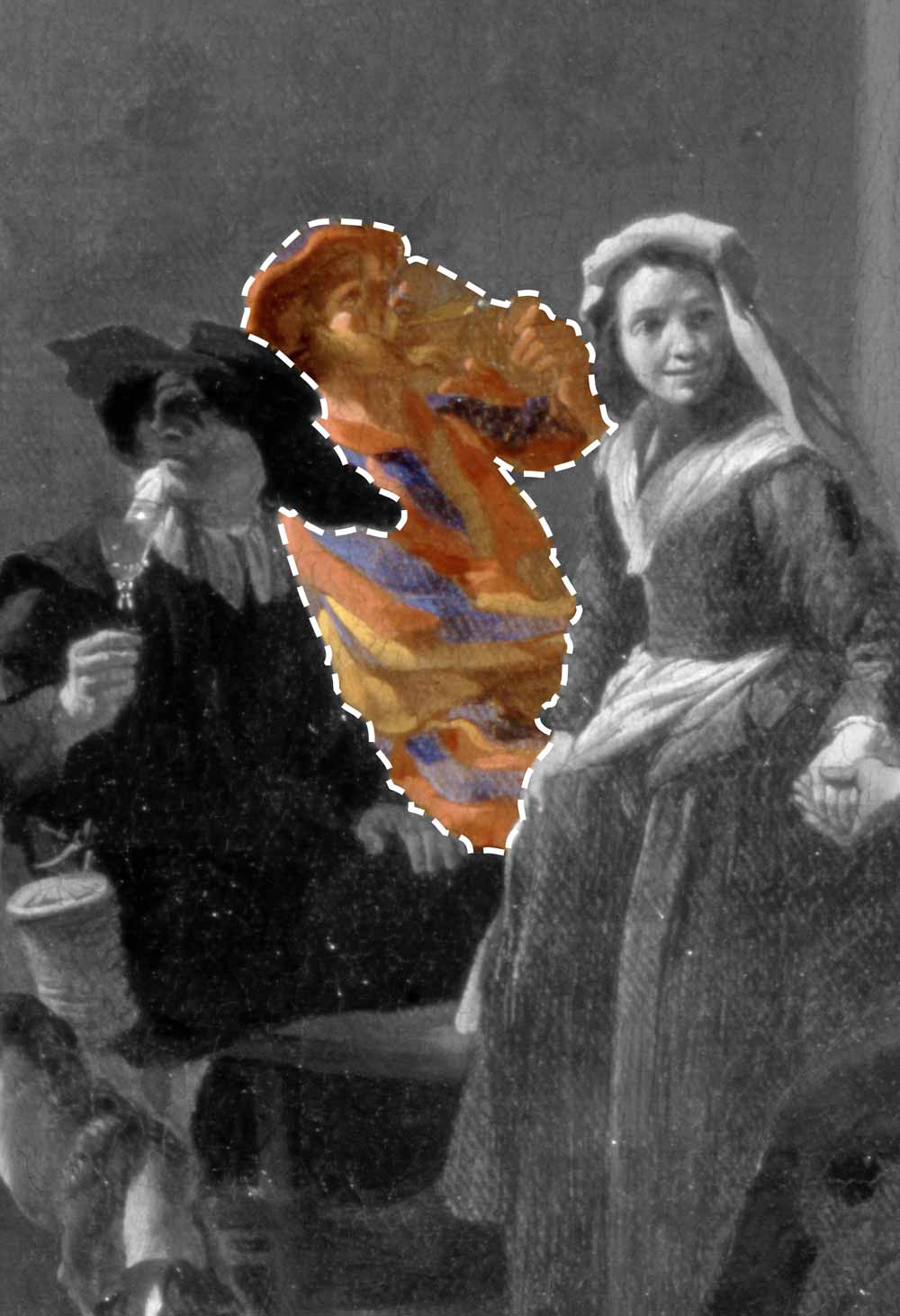
Scaramuccia and Colombina
1 The man that is completely dressed in black and is also wearing a black mask is probably Scaramuccia, a special form of Capitano, the vain captain. He is a daredevil in word, but despondent in deed. This character is associated with the soldiers of the Spanish occupation in Italy in the 16th century. In this picture, however, the cut of clothing and the tassel-shaped decorative elements are hardly evocative of their military origins, but give them a rather comical touch. Aside from masks and costumes, the characters of the Commedia dell'arte can also be identified through their respective language and their individual gestures. Not surprisingly, Scaramuccia's pose in Miel's Dance in the Trattoria is comparable to other depictions of the character.
2 Scaramuccia's dance partner is dressed simply according to her role as Servetta, a low-class maid. Contrary to the other paired figures, she often appears as a single figure in the plays of the Commedia dell'arte. The most famous character among all the maids and servants is Colombina. Like all female roles in Italian comedy, she is primarily considered as an object of pleasure for male phantasies.
The couple is dancing exuberantly to the sounds of music. Which dance is being performed here?
Let's dance Saltarello!
Colombina and Scaramuccia are dancing Saltarello. This Hop dance (saltare = to jump), which has been well known in Italy since the late Middle Ages, in the 17th century was especially popular in Central Italy and as well as in Rome.
It is danced quickly with increasing speed in three-four time. However, the exact sequence of steps is not known and is only documented via image sources such as Jan Miel's paintings.
Everyday life in a Roman tavern
The innkeeper is serving his guest, who is just finishing a plate of noodles, sausages on the skewer. The still life of kitchen utensils arranged in front of the draw well and the puppy dog provide the picturesque setting for this quotidian scene in a Roman tavern which corresponds to contemporary styles of genre painting.
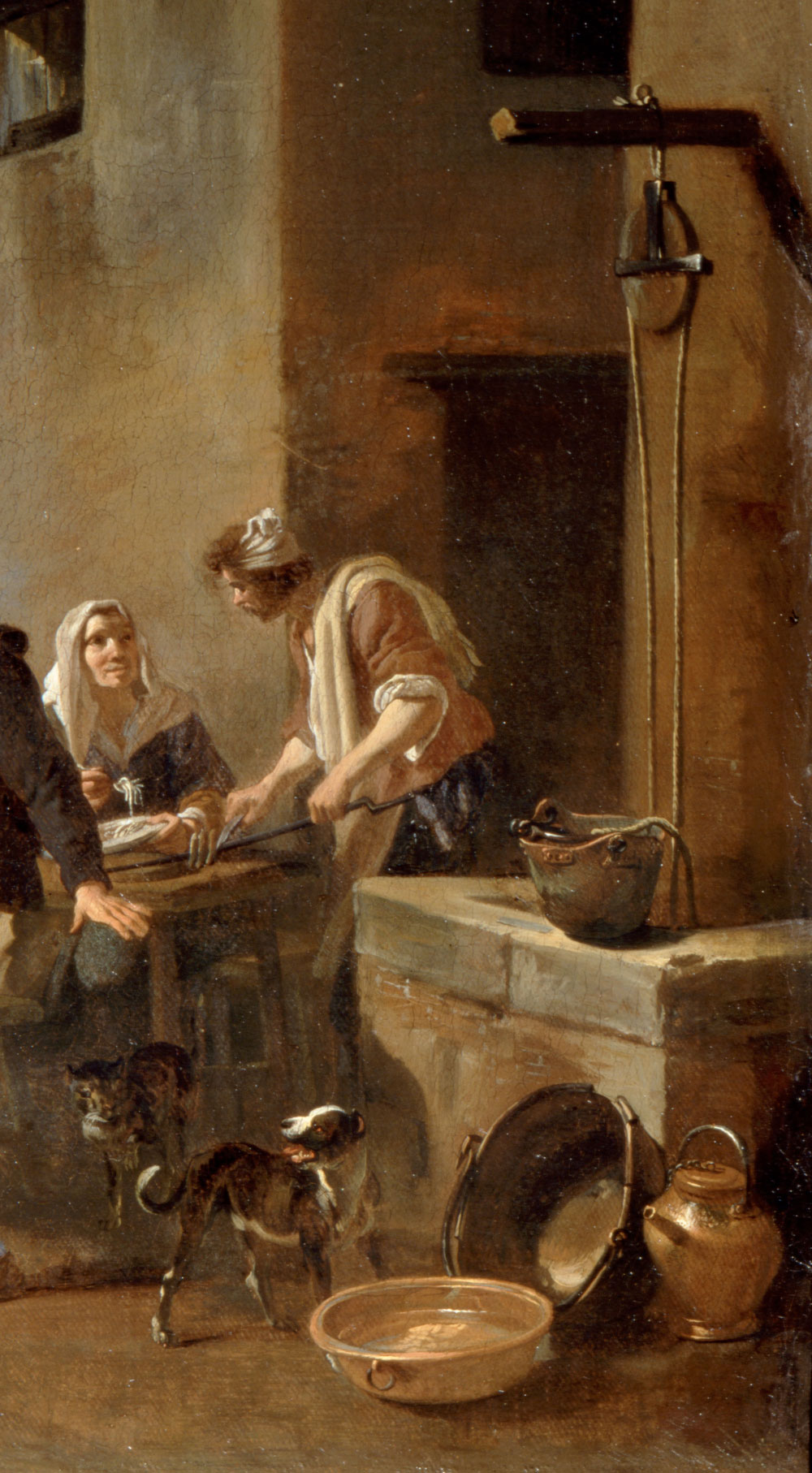
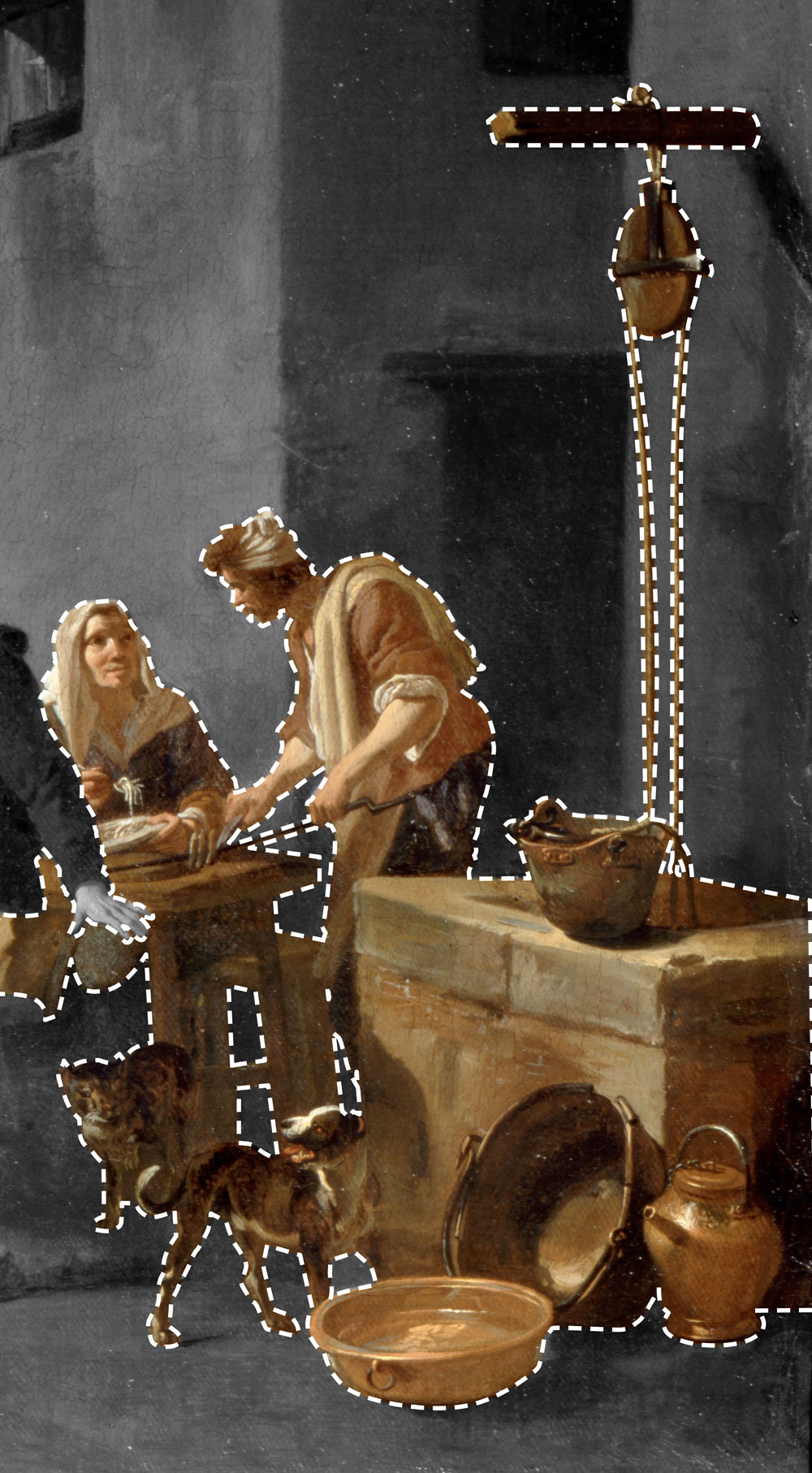
Jan Miel (1599–1664) A Flemish man in Rome
Jan Miel's beginnings are in the dark. An apprenticeship with Anthonis van Dyck, as reported by biographers, is not very credible. A contemporary of Peter Paul Rubens, Miel was first mentioned as an artist in Rome in the 1630s, more precisely in a document from 1636. In Rome, the Flemish painter joined the Dutch artists' colony Schildersbent (a “painters gang”), which had been founded in 1622. Referring to his family name – miele in Italian means “honey” – his fellow-friends gave him the nickname Honingh-Bie, “honey-bee”. In the beginning he dedicated his work to the genre painting in the style of Pieter van Laer.
Miel's Carnevalate, which also includes Dance in the Trattoria, are regarded an original contribution to this then newly introduced genre. Later, under the influence of Italian painting and especially that of the academic painter Andrea Sacchi, he changed to history painting.
In 1647 Jan Miel became a member of the confraternity of San Giuliano Fiamminghi, in 1648 of the local Lucas guild and in 1650 of the Virtuosi al Pantheon. Following study tours within Italy in 1654, Miel moved to Turin in 1659, where he was appointed court painter of Duke Carlo Emanuele II from Savoy. He never returned to his home country and died in Turin in 1664.
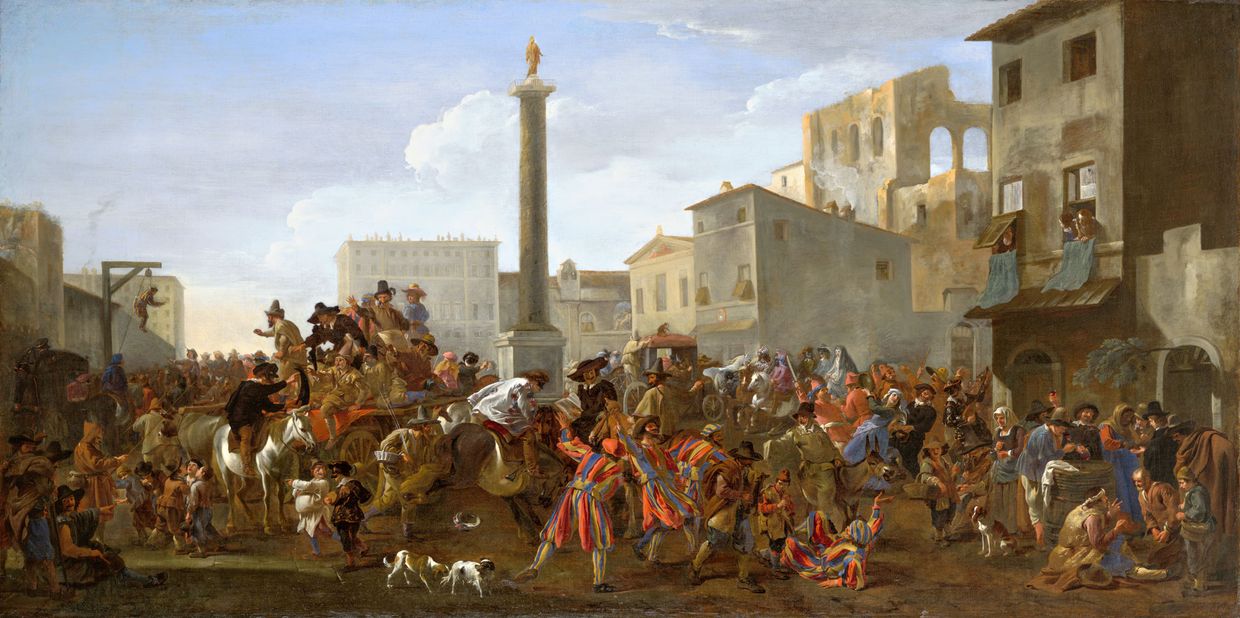
Miel's Carnevalate as an insight into the Roman Carnival …
The Dance in theTrattoria belongs to a group of works by Jan Miel that show masked and costumed figures on squares and alleys. Created during the artist's stay in Rome between 1648 and 1653, this series is associated with the Roman Carnival. Key piece of these carnival depictions, the so-called Carnevalate, is a large-format painting that was
commissioned 1645 by the Genoese nobleman Marchese Tommaso Raggi (1595/96–1679). This painting vividly captures the distinctive customs of the carnival, such as the symbolic lifting of fools on the gallows. Is there a clear reference to the carnival in Dance in the Trattoria and the other paintings of this series?
… or is it all theater?
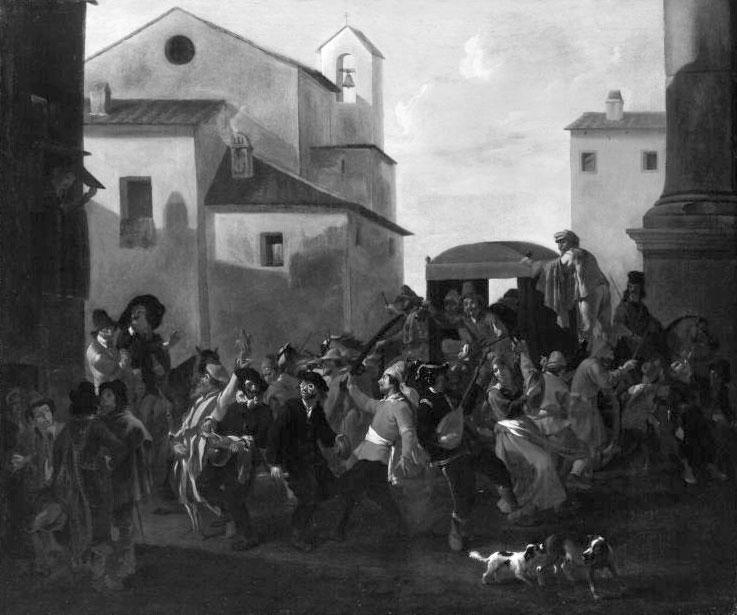
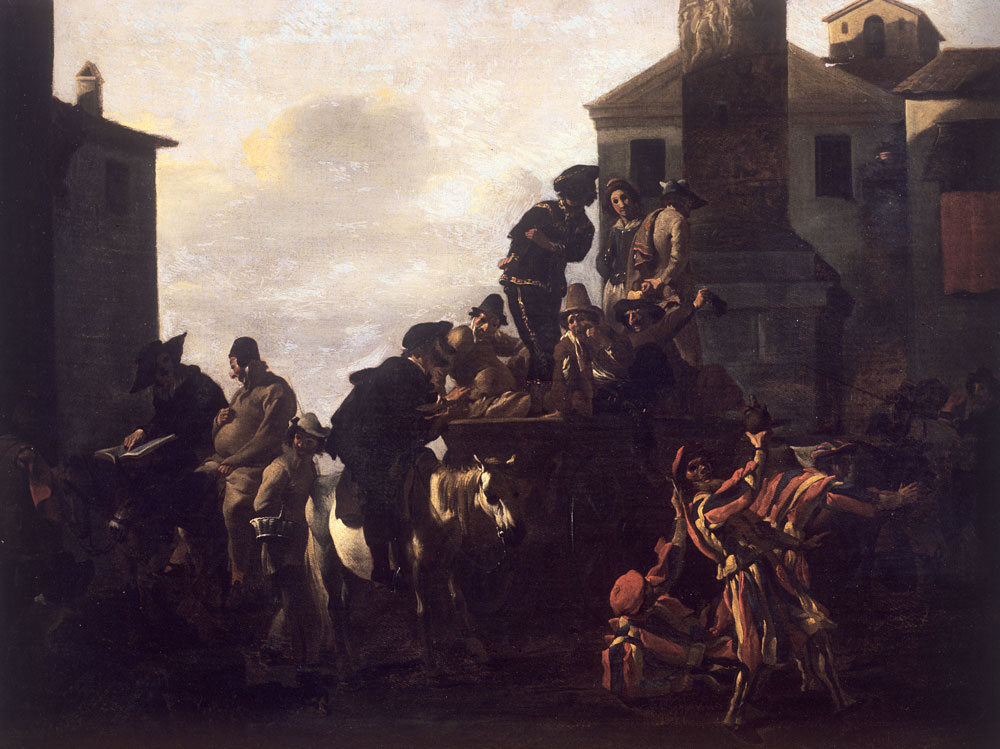
Jan Miel's Carnevalate present masked and costumed groups of figures. A closer look reveals that the repertoire of figures is always the same. In contrast to the large-format painting Carnival on the Piazza Colonna in Rome for the Genoese aristocrat Marchese Raggi, the number of figures and the variety of masks and costumes are significantly reduced in the pictures of smaller size. However, in this series Jan Miel seems to highlight a particular group of figures. In fact, they correspond in part to those in Raggi's panoramic view of the Roman carnival, namely the group on the wagon left of the pillar. These are not ordinary people disguised for carnival, but rather actors.
Since the 16th century, improvised comedies have been performed on the streets and squares of Italian cities to entertain the people. The performers, professional actors and as well actresses, were part of fixed companies that travelled from place to place, city to city. Miel's Carnevalate usually captures those magical moments, when they drove up narrow streets or wide squares and attracted the attention of residents and passers-by through gestures and shouts. The wagon pulled by oxen in Miel's painting serves not only as a means of transport, but also as a stage.
During his long stay in Rome, the Flemish painter undoubtedly encountered various theater companies of the Commedia dell'arte. Also the Paintings Gallery of the Viennese Academy's Dance in the Trattoria mainly features figures from the Italian comedy. But this painting differs in one essential point from the others, namely by showing the theatre company in the courtyard of a tavern out of the sight of the public enjoying music, dance and wine. Do they rehearse their next play? Do they relax after a long journey? Or do they celebrate after a successful performance? What do you think?
Selected Bibliography
David Esrig, Commedia dell‘arte. Eine Bildgeschichte der Kunst des Spektakels. Delphi, Nördlingen 1985.
Claudia Koch, „Tanz in der Trattoria“, in: Sabine Haag und Gudrun Swoboda, Feste Feiern. Kunsthistorisches Museum, Vienna 2016, p. 275.
Thomas Kren, Jan Miel (1599-1664). A Flemish painter in Rome. Ph. D. Yale University 1978, Photocopy (typescript), Ann Arbor, Michigan 1989.
David A. Levine und Ekkehard Mai, I Bamboccianti. Niederländische Malerrebellen im Rom des Barock. Electa, Milan 1991.
Rudi Risatti (Hrsg.), Groteske Komödie in den Zeichnungen des Lodovico Ottavio Burnacini. Hollitzer, Vienna 2019.
Renate Trnek, Die holländischen Gemälde des 17. Jahrhunderts in der Gemäldegalerie der Akademie der bildenden Künste Wien. Böhlau Verlag, Wien, Köln, Weimar 1997.
Renate Trnek, Traum vom Süden. Die Niederländer malen Italien. Hatje Cantz, Ostfildern – Vienna 2007.
Title: Dance in the Trattoria by Jan Miel. Masquerade or theatre?
Author: Claudia Koch (Vienna, The Paintings Gallery of the Academy of Fine Arts)
Web Design: Kunsthistorisches Museum – Visual Media, Vienna
English Translation: Claudia Koch and Astrid Lehner
Provenance of images: London, The Royal Collection Trust; Madrid, Museo Nacional del Prado; Middletown, Open Access Image from the Davison Art Center, Wesleyan University (photo: M. Johnston); Rome, Gallerie Nazionali di Arte Antica. Palazzo Barberini (courtesy of the Gallerie Nazionali di Arte Antica, MIBACT-Bibliotheca Hertziana, Istituto Max Planck for the Histoy of Art/Enrico Fontolan); Munich, Bayerische Staatsgemäldesammlungen, Alte Pinakothek; Vaduz-Vienna, LIECHTENSTEIN. The Princely Collections; Vienna, Paintings Gallery and Graphic Collection of the Academy of Fine Arts Vienna; Vienna, Kunsthistorisches Museum and Theatermuseum.
Music: Simone Vallerotonda & I Bassifondi (Hieronimus Kapsberger "Preludio e Sfessania")
